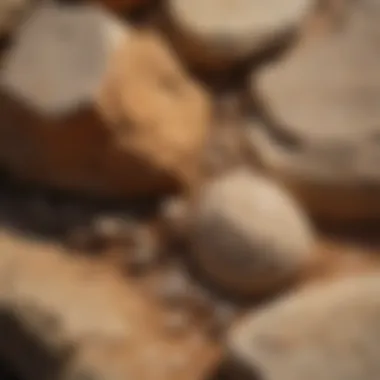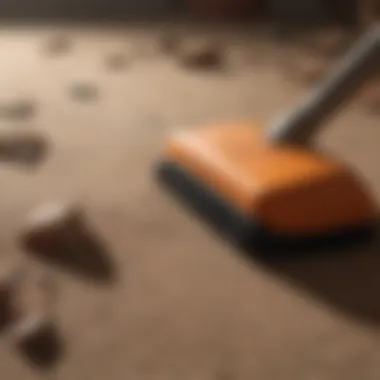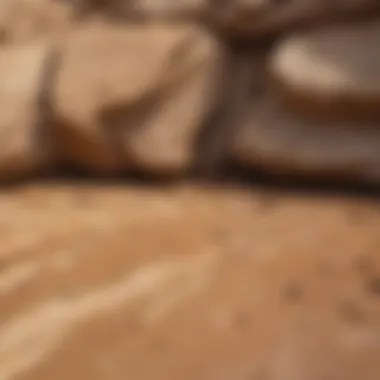Unlocking the Secrets: Best Sandstone Cleaner for Geological Collectors Revealed


Rock and Fossil Identification
Sandstone is a prevalent sedimentary rock composed of sand-sized minerals or rock grains. Understanding the unique properties of sandstone is key for geological collectors. Its composition, color variations, and texture can offer valuable insights into its formation process and origin. When identifying sandstone, collectors should look for specific characteristics such as grain size, cementing material, and the presence of fossils within the rock matrix. Various tools, including magnifying glasses, geologist hammers, and color charts, can aid in accurately identifying sandstone specimens.
Collecting Tips and Techniques
Geological collectors are always on the lookout for prime sites to collect sandstone specimens. Best practices for collecting include obtaining permission before extracting specimens, respecting natural habitats, and recording the collection location for future reference. Locating prime collecting sites may involve research, joining geological clubs, or collaborating with fellow collectors to share valuable information. When extracting specimens, collectors should use proper tools like rock chisels and brushes to ensure the safe removal of sandstone samples without causing damage.
Preservation and Display
Preserving sandstone specimens is crucial for maintaining their natural beauty and scientific value. Techniques such as cleaning with gentle brushes, storing in acid-free containers, and avoiding exposure to direct sunlight can help prevent deterioration over time. Proper storage methods involve utilizing padded storage boxes, silica gel packets for moisture control, and labeling each specimen with relevant information. Creative display ideas for sandstone may include arranging specimens in chronological order, grouping them by geological era, or incorporating them into decorative art pieces to showcase their unique characteristics.
Geological Insights
Sandstone provides valuable insights into geological formations and processes that have shaped the Earth's surface over millions of years. Understanding the historical significance of sandstone can shed light on past environments, ancient climate conditions, and notable events in Earth's history. Notable discoveries in the field of geology often involve uncovering unique sandstone formations that reveal clues about prehistoric landscapes, extinct species, or geological events that have shaped the planet's topography.
Introduction
Sandstone, with its unique geological composition and striking aesthetic appeal, holds a special place in the world of geological collections. As geological collectors, understanding the intricacies of sandstone composition and the significance of proper cleaning techniques are paramount in preserving the natural beauty of these cherished specimens. This article serves as a detailed guide, delving into the nuances of selecting the best sandstone cleaner to maintain and enhance the longevity of your geological treasures.
Understanding Sandstone Composition
Composition of Sandstone
Sandstone, characterized by its granular texture and diverse mineral content, is a sedimentary rock formed over centuries through the accumulation of sand grains. The composition of sandstone varies, with common minerals like quartz, feldspar, and mica contributing to its unique properties. Its porous nature allows for intricate patterns and color variations, making it a sought-after choice for geological collections. However, these pores can also trap dirt and impurities, necessitating gentle and effective cleaning methods for preservation.
Properties of Sandstone
The properties of sandstone extend beyond its composition, encompassing characteristics such as durability, porosity, and color variations. Its natural texture and structural integrity make it ideal for both indoor displays and outdoor installations. With a wide range of colors and patterns available, sandstone offers geological collectors a diverse selection to elevate their collections. Yet, its porous nature requires careful maintenance to prevent degradation and preserve its unique aesthetic appeal.


Importance of Proper Cleaning
Preservation of Geological Specimens
Preservation lies at the core of proper sandstone cleaning, ensuring the longevity and integrity of geological specimens. By employing gentle cleaning techniques and suitable products, collectors can safeguard the intrinsic qualities of sandstone, including its color vibrancy and texture. Effective preservation not only maintains the geological specimen's original state but also protects it from environmental elements that could compromise its visual appeal and structural integrity.
Enhancing Aesthetic Appeal
Beyond preservation, proper cleaning of sandstone enhances its aesthetic appeal, bringing out the richness of color and texture inherent in each specimen. By removing dirt, stains, and impurities, collectors can reveal the true beauty of sandstone, elevating its visual impact within their collections. The process of cleaning not only revitalizes the appearance of geological specimens but also allows collectors to showcase the natural allure and uniqueness of each piece.
Factors to Consider
When delving into the realm of selecting the best sandstone cleaner for geological collectors, there are several critical factors to consider. One of the primary considerations is the gentleness of the cleaner. Opting for a cleaner that is specifically formulated to be non-abrasive can be pivotal in preserving the delicate nature of sandstone without causing any damage. Additionally, choosing a pH-neutral solution is paramount to ensure that the cleaner is not too acidic or alkaline, which could potentially harm the sandstone specimens over time. By carefully evaluating the gentleness of the cleaner, collectors can safeguard their geological treasures for the long haul.
Gentleness of the Cleaner
Non-Abrasive Formulas
Non-abrasive formulas play a crucial role in the cleaning process of sandstone specimens. The key characteristic of these formulas lies in their smooth and gentle composition, which effectively removes dirt and grime without scratching or deteriorating the surface of the sandstone. Their non-abrasive nature makes them a preferred choice for geological collectors looking to clean their specimens without causing any harm. Despite their effectiveness, it's important to note that non-abrasive formulas may require a bit more time and effort to eliminate stubborn stains compared to harsher alternatives.
PH-Neutral Solutions
PH-neutral solutions are vital in maintaining the balance between effective cleaning and preserving the integrity of sandstone. The key characteristic of these solutions is their balanced pH level, which prevents any acidic or alkaline reactions that could potentially damage the sandstone. By opting for a pH-neutral cleaner, collectors can ensure that their specimens are cleaned thoroughly while retaining their natural beauty. However, it's essential to follow manufacturer instructions carefully when using PH-neutral solutions to achieve optimal results.
Effectiveness
Removal of Dirt and Stains
An effective sandstone cleaner should excel in removing dirt and stains from the surface of geological specimens. Successful removal of these impurities not only enhances the visual appeal of the sandstone but also helps in maintaining its natural textures. The key characteristic of a good cleaner lies in its ability to penetrate deep into the porous structure of sandstone to lift and eliminate dirt particles without causing any harm. Selecting a cleaner that effectively tackles dirt and stains is imperative for collectors aiming to showcase the true beauty of their geological treasures.


Preservation of Natural Texture
Preserving the natural texture of sandstone is another crucial aspect to consider when choosing a cleaner. An ideal cleaner should not only clean the surface but also ensure that the unique textures and patterns of the sandstone remain intact. The key characteristic of a cleaner geared towards preserving natural texture is its ability to gently clean without altering the original features of the specimens. By prioritizing the preservation of natural texture, collectors can enjoy showcasing the authentic beauty of their sandstone collections for years to come.
Top Sandstone Cleaners
In the realm of geological collections, the significance of selecting the right sandstone cleaner cannot be understated. The preservation of precious specimens lies in the efficacy of these cleaners, ensuring longevity and maintaining the beauty of the stones. When exploring the best sandstone cleaners, various factors come into play, such as the composition of the cleaner, its gentleness on the stones, and its overall effectiveness. Geologists and collectors alike value products that not only clean but also nourish and protect the natural qualities of the sandstone, making the choice of cleaner a critical decision.
Natural vs. Chemical Cleaners
Benefits of Natural Cleaners
Natural cleaners offer a compelling alternative to their chemical counterparts for geological collectors. Their organic composition ensures a gentle yet effective clean, retaining the essence of the sandstone without causing any harm. The primary benefit of natural cleaners lies in their ability to cleanse the stones without leaving behind any chemical residue or altering their natural characteristics. For collectors who prioritize environmental sustainability and maintaining the integrity of their specimens, natural cleaners stand out as the preferred choice.
Efficiency of Chemical Solutions
Chemical solutions, on the other hand, boast exceptional efficiency when it comes to removing stubborn stains and dirt from sandstone surfaces. Their powerful formulas penetrate deep into the pores of the stone, ensuring a thorough cleanse that brings out the natural beauty of the specimens. While chemical solutions may contain stronger ingredients, they are often selected for their quick and reliable results. Collectors seeking a rapid yet effective cleaning solution often opt for chemical cleaners to rejuvenate and revitalize their sandstone treasures.
Recommended Products
Product A: Organic Sandstone Cleaner
Product A, the Organic Sandstone Cleaner, presents a unique blend of natural ingredients tailored to delicately clean and protect sandstone specimens. Its key characteristic lies in its ability to lift stains and grime gently, without compromising the texture or color of the stones. This organic cleaner offers collectors a sustainable and eco-friendly option for maintaining their geological treasures, ensuring longevity and visual appeal.
Product B: pH-Neutral Solution
Product B, the pH-Neutral Solution, stands out for its balanced formula that preserves the delicate pH levels of sandstone while effectively cleansing the surfaces. Its key characteristic of being gentle yet potent makes it a popular choice among collectors looking for a versatile cleaner that can tackle various types of dirt and stains. This solution's unique feature lies in its ability to restore the natural luster of sandstone without causing any damage, making it a reliable option for enhancing the aesthetic appeal of geological specimens.
Application Techniques


In this segment, we delve into the crucial aspect of application techniques when it comes to selecting the best sandstone cleaner for geological collectors. Proper application is vital to ensure effective cleaning without damaging the delicate sandstone surfaces. By understanding the correct methods of applying cleaners, collectors can maintain the integrity of their specimens while enhancing their visual appeal. The techniques discussed here play a pivotal role in the preservation of geological treasures, offering a detailed guide to achieve optimal cleaning results.
Preparation Steps
Surface Inspection
Surface inspection before cleaning is a fundamental step in assessing the condition of the sandstone. By carefully examining the surface, collectors can identify areas that require specific attention and determine the most suitable cleaning approach. This meticulous inspection process enables collectors to target stains, dirt, or damage accurately, ensuring a thorough cleaning process tailored to the unique characteristics of each specimen.
Test Cleaning
Test cleaning involves applying a small amount of the chosen cleaner to a discreet area of the sandstone to assess its compatibility and effectiveness. This preliminary test helps collectors evaluate how the cleaner interacts with the stone without risking damage to the entire specimen. Through test cleaning, collectors can fine-tune their cleaning methods, ensuring that the chosen cleaner achieves optimal results without causing harm to the sandstone.
Cleaning Process
Applying the Cleaner
The application of the cleaner is a critical stage that requires precision and care. By following recommended instructions and using the appropriate tools, collectors can effectively apply the cleaner to the sandstone surface. Proper application ensures that the cleaner penetrates dirt and grime, enabling thorough cleaning without residual damage. The technique of applying the cleaner directly impacts the overall cleaning results, making it essential to adhere to best practices for optimal outcomes.
Gentle Scrubbing
Gentle scrubbing is a methodical approach that aids in removing tough stains and dirt from the sandstone surface. Using gentle pressure and non-abrasive materials, collectors can delicately scrub the affected areas to lift grime without causing scratches or abrasions. This gentle scrubbing technique enhances the cleaning process by targeting specific areas effectively while safeguarding the natural texture of the sandstone. Implementing gentle scrubbing ensures thorough cleaning results while preserving the intrinsic beauty of the geological specimens.
Conclusion
The concluding section of this article serves as a vital segment to encapsulate the significance and essence of selecting the best sandstone cleaner for geological collectors. It synthesizes the key points discussed throughout the guide, emphasizing the critical role of proper cleaning methods in the maintenance and preservation of valuable geological specimens. By highlighting the importance of utilizing the right cleaning products and techniques, collectors can prolong the lifespan of their sandstone treasures and enhance their aesthetic appeal, ensuring their long-term visual and structural integrity is maintained.
Maintaining Geological Treasures
Prolonging Lifespan of Sandstone
Delving into the aspect of prolonging the lifespan of sandstone unveils a crucial factor in the care and preservation of geological specimens. This particular focus aims to extend the durability and longevity of sandstone formations, safeguarding them against natural wear and environmental factors. The key characteristic of this practice lies in its ability to shield sandstone from erosion, corrosion, and degradation over time, thereby preserving their unique geological attributes. Prolonging the lifespan of sandstone is a prudent choice for collectors due to its effectiveness in maintaining the structural integrity and visual appeal of these natural formations. The unique feature of this method lies in its ability to provide long-term protection while retaining the authenticity and beauty of the sandstone, safeguarding it for future generations to appreciate and study.
Enhancing Visual Appeal
In the realm of geological conservation, enhancing the visual appeal of sandstone plays a pivotal role in showcasing the inherent beauty and distinct characteristics of these geological wonders. This aspect focuses on accentuating the vibrant colors, intricate patterns, and natural textures present in sandstone formations, elevating their aesthetic allure. The key characteristic of enhancing visual appeal revolves around transforming weathered or soiled surfaces into vibrant displays of geological artistry, captivating collectors and enthusiasts alike. Choosing to enhance the visual appeal of sandstone is a popular choice for its ability to revitalize and rejuvenate the appearance of geological specimens, bringing out their inherent beauty and enhancing their overall presentation. The unique feature of this approach lies in its capacity to renew the visual splendor of sandstone, offering a renewed perspective on these natural treasures and revitalizing their allure within geological collections.







